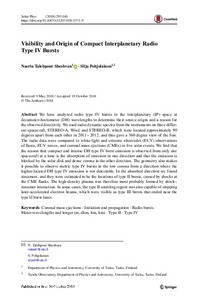Visibility and Origin of Compact Interplanetary Radio Type IV Bursts
Sheshvan NT; Pohjolainen S
Visibility and Origin of Compact Interplanetary Radio Type IV Bursts
Sheshvan NT
Pohjolainen S
SPRINGER
Julkaisun pysyvä osoite on:
https://urn.fi/URN:NBN:fi-fe2021042720199
https://urn.fi/URN:NBN:fi-fe2021042720199
Tiivistelmä
We have analyzed radio typeIV bursts in the interplanetary (IP) space at decameter-hectometer (DH) wavelengths to determine their source origin and a reason for the observed directivity. We used radiodynamic spectra from the instruments on three different spacecraft, STEREO-A, Wind, and STEREO-B, which were located approximately 90 degrees apart from each other in 2011-2012, and thus gave a 360 degree view of the Sun. The radio data were compared to white-light and extreme ultraviolet (EUV) observations of flares, EUV waves, and coronal mass ejections (CMEs) in five solar events. We find that the reason that compact and intense DH typeIV burst emission is observed from only one spacecraft at a time is the absorption of emission in one direction and that the emission is blocked by the solar disk and dense corona in the other direction. The geometry also makes it possible to observe metric typeIV bursts in the low corona from a direction where the higher-located DH typeIV emission is not detectable. In the absorbed direction we found streamers, and they were estimated to be the locations of typeII bursts, caused by shocks at the CME flanks. The high-density plasma was therefore most probably formed by shock-streamer interaction. In some cases, the typeII-emitting region was also capable of stopping later-accelerated electron beams, which were visible as typeIII bursts that ended near the typeII burst lanes.
Kokoelmat
- Rinnakkaistallenteet [27094]
